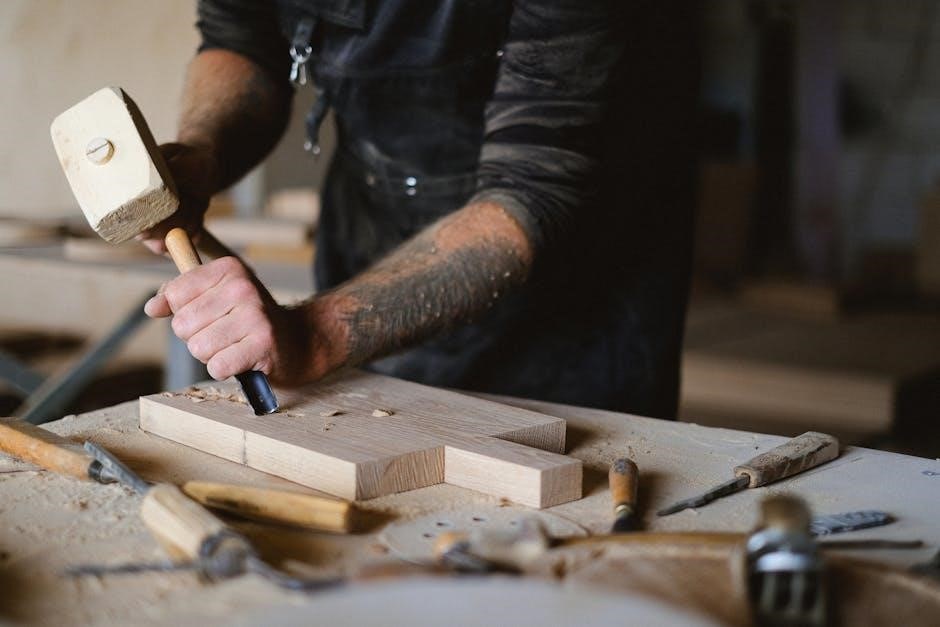A wood chipper is a machine designed to reduce wood into smaller chips for various purposes, such as mulching or composting, simplifying yard waste management efficiently.
1.1 What Are Wood Chippers?
A wood chipper is a machine designed to process wood into smaller chips or shreds, ideal for mulching, composting, or managing yard waste efficiently. These devices typically feature a chute for feeding branches and leaves, with internal blades that cut the material into uniform pieces. Available in various sizes, wood chippers can handle small twigs or large tree limbs, depending on the model. They are powered by electric motors, gas engines, or diesel engines, offering portable solutions for homeowners, landscapers, and professionals. The output chips can be used for garden beds, pathways, or biofuel production, making them versatile tools for wood management.
1.2 Importance of Wood Chippers in Yard Maintenance
Wood chippers play a vital role in yard maintenance by efficiently converting branches, leaves, and debris into manageable wood chips. This process helps keep yards tidy, reduces waste, and minimizes the need for frequent cleanups. The resulting chips can be repurposed as mulch or compost, enriching soil and promoting plant growth. By breaking down large amounts of organic material, wood chippers also reduce landfill contributions and support eco-friendly practices. Regular use of a wood chipper saves time, effort, and money, making it an essential tool for homeowners and professionals seeking to maintain a clean, sustainable outdoor space.

Types of Wood Chippers
Wood chippers come in various types, including electric, gas-powered, and homemade models, each offering unique benefits for different yard maintenance needs and scales of operation.
2.1 Electric Wood Chippers
Electric wood chippers are a cost-effective and eco-friendly option for small-scale yard maintenance. They are lightweight, quiet, and ideal for processing branches up to 3 inches in diameter. These chippers are powered by electric motors, reducing emissions and operating costs. With minimal maintenance required, they are perfect for homeowners seeking a reliable tool for mulching and composting. Their compact design allows easy storage and portability, making them a practical choice for urban and suburban settings. Additionally, electric chippers are user-friendly and offer consistent performance for regular yard cleanup tasks.
2.2 Gas-Powered Wood Chippers
Gas-powered wood chippers are robust machines designed for heavy-duty tasks, offering higher power and versatility compared to electric models. Equipped with powerful engines, they can handle thicker branches and larger quantities of debris. These chippers are ideal for extensive yard work or commercial applications, providing consistent performance in challenging conditions. With features like high-capacity chutes and durable blades, they ensure efficient wood processing. Gas-powered models are also portable, making them suitable for remote locations. While they require more maintenance and fuel, their reliability and strength make them a top choice for professionals and homeowners with significant wood-chipping needs.
2.3 Homemade and DIY Wood Chippers
Homemade and DIY wood chippers offer a cost-effective and customizable solution for processing wood and debris. These machines are often built using readily available materials, such as old lawn mowers or small engines, and can be tailored to specific needs. DIY chippers are ideal for small-scale projects, allowing users to repurpose wood waste efficiently. While they may lack the power of commercial models, homemade chippers provide a sustainable and budget-friendly alternative for yard maintenance. With proper design and safety precautions, DIY wood chippers can be a practical tool for homeowners and woodworking enthusiasts.

Safety Guidelines
Operating a wood chipper safely requires wearing protective gear, following manual instructions, and maintaining awareness of moving parts. Always ensure proper training and caution to prevent accidents.
3.1 General Safety Tips
Always wear protective gear, including gloves, goggles, and steel-toe boots, when operating a wood chipper. Keep loose clothing tied back and avoid jewelry that could get caught. Maintain a safe distance from moving parts and ensure children and pets are away. Never operate the machine while fatigued or under the influence of alcohol. Ensure the area is clear of debris and obstacles. Keep the machine well-maintained, following the manual’s guidelines. Avoid overloading the chipper, as this can cause jams or accidents. Stay alert and never reach into the chute while the machine is running. Proper training and awareness are key to safe operation.
3.2 Personal Protective Equipment
Wearing proper protective gear is essential when operating a wood chipper. Always use safety goggles to protect your eyes from flying debris. Steel-toe boots or sturdy footwear are necessary to prevent foot injuries. Durable gloves improve grip and safeguard hands from cuts or abrasions. Avoid loose clothing or jewelry that could get caught in moving parts. A dust mask is recommended to avoid inhaling wood particles. Hearing protection, such as earplugs, is also advisable due to the machine’s loud operation. Ensure all protective equipment is securely in place before starting the chipper to minimize accident risks and ensure safe operation.
3.3 Emergency Procedures
In case of an emergency, immediately turn off the wood chipper’s engine and disconnect the power source. Never reach into the machine to clear a blockage while it is operational. If a blockage occurs, wait for all moving parts to stop before inspecting or clearing debris. In case of injury, provide first aid and seek medical attention promptly. Keep a fire extinguisher nearby, as wood chipping can generate dust and heat. Always follow the manufacturer’s guidelines for emergency situations. Stay calm and act swiftly to prevent further damage or harm.

Maintenance and Repair
Regular maintenance ensures optimal performance and longevity. Sharpen blades frequently, check oil levels, and inspect for wear; Schedule routine inspections to prevent mechanical issues and ensure safety.
4.1 Regular Maintenance
Regular maintenance is crucial for ensuring the wood chipper operates efficiently and safely. Inspect and sharpen blades frequently to maintain cutting performance. Lubricate moving parts to reduce friction and wear. Check oil levels and filter condition, replacing as needed. Clear debris from the chute and discharge area to prevent clogs. Empty the collection bag after each use to avoid buildup. Schedule routine inspections of belts, hoses, and safety features. Address any worn or damaged components promptly to prevent costly repairs. Always consult the user manual for specific maintenance recommendations tailored to your model.
4.2 Long-Term Maintenance
For long-term maintenance, ensure your wood chipper is serviced annually by a professional to check for internal wear and tear. Winterize the machine by draining fluids and applying rust-proof coatings. Store it in a dry, covered area to protect against weather damage. Replace worn or corroded parts, such as chippers blades or shredder hammers, every 2-3 years. Regularly inspect the engine and hydraulic systems for leaks or damage. Keep a maintenance log to track service history and ensure optimal performance over time. Proper long-term care extends the lifespan and reliability of your wood chipper, ensuring consistent results season after season.
4.3 Troubleshooting Common Issues
Common issues with wood chippers include clogged feed systems, dull blades, and engine overheating. If the machine stalls, check for blockages and ensure proper material feeding. Dull blades can slow performance; sharpen or replace them as needed. For overheating, inspect coolant levels and ensure adequate airflow. Lubricate moving parts regularly to prevent friction damage. If the chipper vibrates excessively, balance the blades or tighten loose components. Addressing these issues promptly prevents further damage and ensures smooth operation. Always refer to the manual for specific troubleshooting guidance tailored to your model.
4.4 Repair Tips
Regular inspection and maintenance are crucial for extending the life of your wood chipper. Replace dull or damaged blades to ensure optimal performance. Lubricate moving parts to reduce friction and prevent overheating. If the engine stalls, check the fuel and air filter. For clogged systems, disassemble and clean thoroughly. Always use genuine replacement parts to maintain warranty and performance. Addressing repairs promptly prevents minor issues from becoming major problems. Consult the manual for specific repair procedures tailored to your model, ensuring safety and efficiency during the process.
Operational Guide
Operating a wood chipper requires selecting the right model for your needs, following safety guidelines, and ensuring proper techniques for efficient wood processing and debris management.
5.1 Choosing the Right Wood Chipper
Selecting the right wood chipper involves considering power source, capacity, and durability. Electric models are ideal for small yards and quiet operation, while gas-powered chippers handle larger branches. Assess your workload to determine the appropriate feed hopper size and engine power. Stainless steel components ensure longevity, and modular designs offer versatility. Compare features like cutting diameter, chute design, and safety standards. Budget and brand support are also crucial factors. Choose a model that aligns with your yard size, debris type, and maintenance preferences for efficient and safe wood chipping operations.
5.2 Step-by-Step Operating Instructions
Start by assembling the chipper according to the manual and ensuring all safety features are functional. Wear protective gear, including gloves and goggles. Power up the machine and test its operation. Feed branches through the chute at a controlled pace, avoiding overloading. For electric models, ensure the area is clear of water. For gas-powered chippers, check oil and fuel levels. Process wood gradually, maintaining a safe distance from moving parts. After use, turn off the engine, allow it to cool, and clean debris. Store the chipper securely, following maintenance guidelines for optimal performance.
5.3 Handling Different Types of Wood and Debris
Understanding the types of wood and debris is crucial for efficient chipping. Start with smaller branches, gradually increasing thickness. For leaves and soft materials, use a shredder chute, while thicker limbs require the chipper chute. Align wood pieces to avoid tangling and ensure smooth processing. Hardwoods like oak may need slower feeding, while softwoods like pine can be processed faster. Avoid mixing wet and dry materials to prevent clogging. Small twigs and leaves can be processed together, but large branches should be chipped separately. Always prioritize uniform sizes for consistent results and to maintain machine efficiency.
Environmental Impact
Wood chippers play a vital role in recycling and waste management by converting debris into mulch, reducing landfill use and promoting sustainable practices for a greener environment.
6;1 Role in Recycling and Waste Management
Wood chippers significantly contribute to recycling and waste management by transforming yard debris, branches, and leaves into reusable materials like mulch or compost. This process reduces landfill dependency and promotes eco-friendly practices. By breaking down organic waste, wood chippers help create nutrient-rich soil amendments, fostering sustainable gardening and agriculture. Additionally, they enable efficient waste reduction, minimizing the environmental footprint of yard maintenance. This practical approach supports greener spaces and aligns with global efforts to combat waste and promote recycling, making wood chippers a vital tool for environmentally conscious waste management strategies.
6.2 Benefits of Mulching and Composting
Mulching and composting with wood chippers offer numerous benefits for garden health and sustainability. Mulch created from wood chips retains soil moisture, suppresses weeds, and regulates temperature, promoting healthy plant growth. Composting organic waste enriches the soil with essential nutrients, reducing the need for synthetic fertilizers. This process minimizes yard waste disposal in landfills, contributing to a greener environment. Additionally, mulching reduces the need for frequent watering and chemical pesticides, fostering eco-friendly gardening practices. By repurposing debris, wood chippers support sustainable gardening and agriculture, enhancing soil fertility and overall ecosystem health.

Advanced Features
Modern wood chippers feature stainless steel durability, tool-less maintenance, and modular designs, ensuring efficiency and longevity. Advanced safety standards and cutting-edge technology enhance performance and user experience significantly.
7.1 Cutting-Edge Technology in Modern Chippers
Modern wood chippers incorporate cutting-edge technology for enhanced performance and efficiency. Advanced features include modular designs, tool-less maintenance, and stainless steel components for durability. Some models boast automatic feeding systems and eco-friendly energy solutions, reducing operational costs and environmental impact. High-speed blades and kinetic cyclonic systems ensure faster and cleaner wood processing. Safety advancements, such as emergency shutdowns and improved stability, prioritize user protection. These innovations make modern chippers more versatile, powerful, and user-friendly, catering to both residential and commercial needs while promoting sustainable waste management practices.
7.2 Energy Efficiency and Eco-Friendly Options
Modern wood chippers emphasize energy efficiency and eco-friendly designs, catering to environmentally conscious users. Electric models reduce emissions and operational noise, while advanced motors optimize energy consumption. Solar-powered options and biofuel compatibility further minimize environmental impact. Lightweight materials and streamlined designs enhance fuel efficiency, reducing carbon footprints; Many chippers now feature cyclonic systems that lower energy use while maintaining performance. These innovations promote sustainable yard maintenance and waste management, aligning with global efforts to reduce pollution and conserve resources. Eco-friendly chippers are a practical choice for homeowners and professionals seeking to balance productivity with environmental responsibility.

Homemade and DIY Solutions
Homemade and DIY wood chippers offer cost-effective alternatives, allowing customization to suit specific needs. Enthusiasts can build compact, efficient machines using basic tools and materials, ideal for small-scale projects.
8.1 Design and Construction
Designing a homemade wood chipper involves creating a compact, efficient machine. Use durable materials like steel for the frame and blades. A feed hopper directs debris into the chipping mechanism, while a discharge chute expels the chips. Choose between electric or gas-powered motors for operation. Ensure safety features like emergency stops and blade guards are included. The design should be portable, with wheels for easy movement. Consider adding a collection bag for mulch. Use readily available tools and materials to keep costs low. Follow detailed plans or modify existing designs to suit your needs and ensure reliable performance.
8.2 Benefits of DIY Wood Chippers
Building a DIY wood chipper offers several advantages. It is cost-effective, as homemade models are often cheaper than store-bought alternatives. DIY chippers allow for customization, enabling users to tailor the machine to their specific needs. They are eco-friendly, turning yard waste into mulch or compost, reducing landfill use. Additionally, DIY projects provide a sense of accomplishment and can be a fun, educational experience. Homemade chippers are also lightweight and portable, making them ideal for small-scale yard maintenance. By repurposing materials, users can create a functional tool while minimizing waste, making it a practical and sustainable solution for yard cleanup.

Commercial and Business Applications
Wood chippers are essential tools in commercial landscaping, forestry, and waste management, offering efficient solutions for large-scale debris processing and creating valuable mulch products for resale.
9.1 Starting a Wood Chipping Business
Starting a wood chipping business is a lucrative venture with minimal startup costs. It involves converting yard waste into mulch, creating a valuable product for landscaping and gardening. Target markets include landscaping professionals, municipalities, and homeowners. Invest in a reliable wood chipper, such as a commercial-grade model with a capacity of 6-12 inches, and essential accessories like trailers or safety gear. Develop a pricing strategy based on volume and delivery requirements. Ensure timely service, prioritize safety, and maintain equipment efficiency to build a loyal customer base. This business can scale easily, offering growth potential in eco-friendly waste management.
9.2 Scaling Your Wood Chipping Operations
Scaling your wood chipping business involves expanding operations to handle larger volumes and diverse clients. Invest in high-capacity chippers, such as 6-inch or 12-inch models, to process more material efficiently. Hire additional staff to manage increased workload and ensure timely delivery. Diversify services by offering bulk mulch sales, landscaping support, or partnerships with tree care companies. Strengthen your online presence and network with local businesses to attract larger contracts. Consider expanding into municipal or commercial sectors for steady demand. Regularly update equipment and train your team to maintain high standards of safety and productivity as your business grows.
Wood chippers are essential tools for efficient yard waste management, offering versatility and sustainability. Regular maintenance and safe operation ensure longevity and effectiveness in various applications.
10.1 Summary of Key Points
Wood chippers are versatile tools essential for yard maintenance, offering efficient waste management by converting debris into usable mulch or compost. Available in electric, gas-powered, or DIY versions, they cater to various needs and budgets. Safety is paramount, requiring proper protective gear and adherence to guidelines. Regular maintenance ensures optimal performance and longevity. Environmentally, chippers promote recycling and reduce landfill waste. For businesses, they provide cost-effective solutions for scaling operations. By understanding types, safety, and maintenance, users can maximize their benefits, making wood chippers indispensable for both residential and commercial applications.
10.2 Final Thoughts on Effective Wood Chipper Use
Effective use of a wood chipper begins with understanding its capabilities and limitations. Always prioritize safety, using appropriate protective gear and following manual guidelines. Regular maintenance ensures longevity and optimal performance. Choosing the right type of chipper for your needs, whether electric, gas-powered, or DIY, maximizes efficiency. Environmental benefits, such as recycling waste into mulch, make chippers eco-friendly tools. By adhering to best practices and maintaining your equipment, you can efficiently manage yard debris while promoting sustainability. Proper usage not only enhances productivity but also contributes to a cleaner, greener environment, making wood chippers indispensable for yard and commercial applications.
